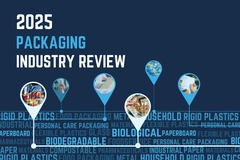Aptar CSP protects FDA-approved home COVID-19 tests with active polymer tech

04 May 2021 --- US-based Aptar CSP Technologies’ Activ-Film technology will be used as protective packaging for two new at-home COVID-19 tests. The tests recently received Emergency Use Authorization (EUA) from the US Food and Drug Administration (FDA).
Badre Hammond, vice president for commercial operations at Aptar CSP, describes the technical challenges in creating packaging for over-the-counter (OTC) COVID-19 tests to PackagingInsights.
“The key challenges were creating a highly engineered matrix that can deliver the material science in different configurations and also be able to create and maintain a microclimate for the final finished product.”
The tests were developed by a leading manufacturer of diagnostic healthcare solutions that offers prescription and OTC COVID-19 at-home testing options without the need to visit a doctor’s office.
Test accuracy protection
Aptar CSP’s Activ-Film technology is integrated into the dipstick of the diagnostic kits to protect against moisture and other environmental conditions that could otherwise impact test accuracy.
Activ-Film leverages Aptar’s proprietary 3-Phase Activ-Polymer platform technology, which provides a broad spectrum of customized and highly engineered solutions in various configurations such as Activ-Vial for housing diagnostics strips and dipsticks, and Activ-Tab, which is integrated within diagnostic cassettes.
This active packaging technology currently protects a range of lateral flow, molecular and electrochemical diagnostic test kits on the market today, including Quidel Corporation’s QuickVue Influenza and COVID-19 tests.
“All of our active material science solutions are custom-formulated to meet the stability needs of each application in a configuration that does not impact the customer’s product design,” says Hammond.
“In this case, our partner had been using our Activ-Film material with other lateral flow diagnostic tests to protect against moisture and other environmental conditions that could affect the signal to noise ratio and impact result accuracy.”
The Actic-Polymer packaging can be customized to various medical packaging needs.Quick to market
The company leveraged its current platform technology to create a specially formulated Activ-Film solution to address specific requirements for the COVID-19 test in an expedited way, given the demands of the pandemic.
“Using a base polymer, channeling agent and active particle, the technology can control the kinetics based upon formulation to create a customized microclimate within the headspace of a sealed package to enhance product stability and shelf life,” explains Hammond.
The channels created within the polymer allow for the movement of gases. The “active” particles added to the polymer can perform a multitude of functions, such as moisture control, gas scavenging, antimicrobial dispersion, aroma emission or odor removal.
“From a physical standpoint, the active polymer can take a wide range of forms such as extruded film or injection molded vials, bottles or custom polymer components. This technology is used to protect a range of diagnostic devices, oral solid dose drugs, medical devices, probiotics, drug delivery systems and even food,” he says.
Active packaging across the board
All versions of the active packaging technology leverage the 3-Phase Activ-Polymer platform to deliver fit-for-purpose solutions, continues Hammond.
“For example, some diagnostic test kits, like those for blood glucose monitoring, may include 25 or 50 diagnostic test strips that need to be protected from moisture. These are often housed in our Activ-Vial solution, which incorporates a 3-Phase Activ-Polymer integrated into the vial.”
The Activ-Vial technology is also formulated to absorb moisture that could otherwise penetrate standard vials, providing test strip protection throughout consumer use.
“Our Activ-Tab molded tablet has the same active function but is configured as a small molded polymer tablet that can be integrated into a diagnostic lateral flow cassette.”
“Also, the Activ-Film used in the COVID-19 test kit is affixed directly onto the test dipstick, though it can function in the same manner by being adhered to a foil pouch housing the dipstick.”
Recyclability
The material is recyclable depending on the final processing methods used during recycling, says Hammond.
“All types of polymers are recyclable, but the extent to which they are recycled is dependent on local collection and recycling infrastructure, which can vary greatly from country to country.”
“A growing number of US communities are implementing recycling programs in an effort to decrease the volume of waste subject to tipping fees at landfills. In some cases, these programs were driven by state-level recycling mandates,” he concludes.
By Louis Gore-Langton











